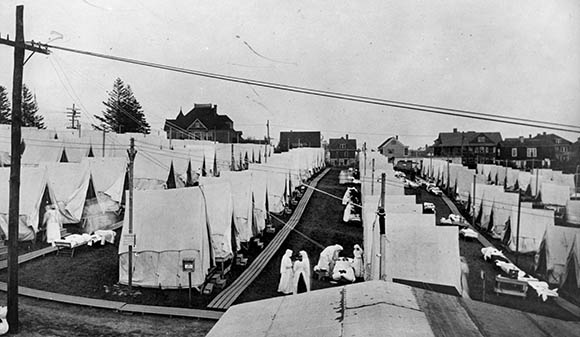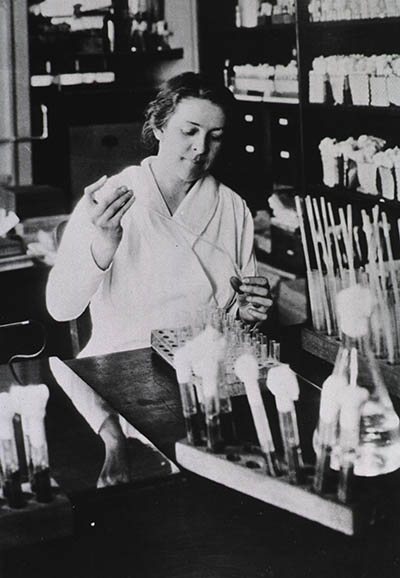From the Annals of NIH History
NIH and the 1918 Flu
A First-hand Account From Alice Evans’s Memoirs
The following is an excerpt from Alice Evans’s memoirs, written in 1963, about her experiences during the 1918 influenza pandemic. Evans, a bacteriologist, was one of the first women scientists at NIH and worked there from 1918 to 1945. Her research led to the recognition of brucellosis as a public-health problem and the acceptance of the need to pasteurize milk.
Perhaps an account of how the influenza pandemic of 1918 affected one member of the staff of the Hygienic Laboratory [the forerunner to NIH] will give [people]…whose knowledge of such epidemics is gained by reading, fortunately not by experience, an idea of the disruption that a serious epidemic may cause.

CREDIT: COURTESY OF THE AMERICAN NATIONAL RED CROSS. ALL RIGHTS RESERVED IN ALL COUNTRIES. © THE AMERICAN NATIONAL RED CROSS 1919
During the 1918 flu pandemic, special hospitals like this one were set up. Pictured: An outside view of the War Influenza Hospital at Emery Hill in Lawrence, Massachusetts (May 29, 1919).
[The 1918 flu] struck Massachusetts in September and reached Washington [D.C.] in early October. Here war-time conditions favored a rapid spread of the disease, for the city was over-filled with dislocated people, the majority of whom were women who had come to do the vastly increased war-time work of the government departments. They were crowded in boarding houses with three or more persons commonly occupying one room as a result of the shortage of housing. When someone became ill and a threat to associates, she was apt to find herself very much alone, with no one to take care of her. Some landladies dismissed boarders coming down with the disease.
On October 1 [1918], Congress passed a resolution “to enable the Public Hea1th Service to combat [the 1918 flu] and other communicable diseases by aiding state and local boards of health or otherwise.”
Some of the medical officers of the Hygienic Laboratory were sent into the field. Those who remained laid aside their research projects to organize emergency hospitals, or to become practicing physicians caring for sick government workers. Due to the absence of the doctors, and to the illness of many others of the Laboratory personnel, only a few were left to carry on.
I presume that there may have been a demand that the government agency should attempt to to find the cause of the epidemic. However that may be, about the middle of the month [Hygienic Laboratory Director] Dr. [George] McCoy asked me to drop my current problem and turn my attention to the subject of greatest concern.
At that time bacteriologists were considering whether the “influenza bacillus” of Pfeiffer (Haemophilus influenzae), which was found quite constantly in cases of influenza, was or was not the etiologic agent of this disease. In later years it was considered to be a secondary invader.
My first thought was that I would examine the sputum of patients and tissues taken at autopsy to find the dominating bacterial species. That study would require a special culture medium. As our media maker was ill, I went to the media-room to make it myself.
Things were not going well, and I knew that I was not skillfully undertaking this job of making media to which I had long been unaccustomed. Gradually I realized that there was something the matter with me, more than the feeling of helplessness on being assigned unexpectedly to an enormous task. Finally I guessed it—I was coming down with the flu. I put away utensils and ingredients and went home. A little more than a month later I returned to work.
It was during those weeks when I was confined to my room that Washington experienced a very serious epidemic. Dr. McCoy became a part-time physician, taking care of the Laboratory’s personnel who were ill with uncomplicated influenza, in addition to his administrative work. Dr. [James] Leake took care of government workers who were seriously ill with pneumonia in temporary hospitals.
Years later: I heard a minister say that during the worst days of those weeks, burial services in Washington cemeteries had to be curtailed in order that each funeral cortege could move along promptly to make room for the next.
When I returned to the Laboratory, I resumed my studies on meningococci, for the war was over, the peak of the epidemic in Washington had passed, and conditions were more favorable for clear-headed thinking. It was recognized that the search for the etiologic agent of influenza was not a problem for a lone investigator. It became a major project of study in more than one institution (but not at the Hygienic Laboratory), and about fifteen years later a team of investigators in a London laboratory discovered that the causal agent is a virus.
About Alice Evans (1881–1975)

CREDIT: NATIONAL LIBRARY OF MEDICINE
Alice Evans, one of the first women scientists to work at NIH (1918–1945), did research that led to the recognition of brucellosis as a public-health problem and the acceptance of the need to pasteurize milk.
Alice Evans was one of the first women scientists to work at NIH. Her research led to the recognition of brucellosis as a public-health problem and the acceptance of the need to pasteurize milk. She received her B.S. in bacteriology from Cornell University (Ithaca, New York) in 1909 and her M.S. from the University of Wisconsin (Madison, Wisconsin) in 1910. She never did earn her Ph.D., which caused a delay in the acceptance of her research findings on brucellosis and milk. Male scientists and milk manufacturers found it hard to believe a woman without a degree. Evans began her federal civil-service career in 1910 with the U.S. Department of Agriculture (USDA) in Wisconsin. In 1913 she moved east to Washington, D.C., to work in the newly completed laboratories of the USDA Dairy Division. In 1918, she inquired of the Hygienic Laboratory whether her services might be of use in connection with the wartime effort; she was hired as a bacteriologist. She joined a team working to improve the serum treatment for epidemic meningitis. Evans retired from NIH in 1945.
This page was last updated on Thursday, March 24, 2022
